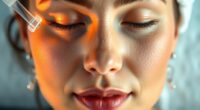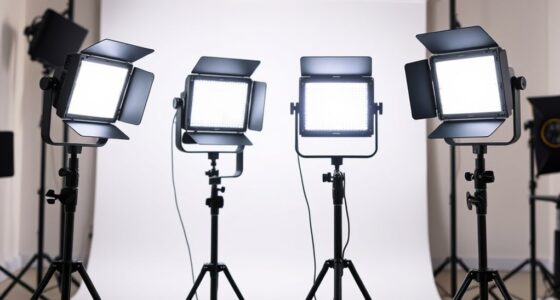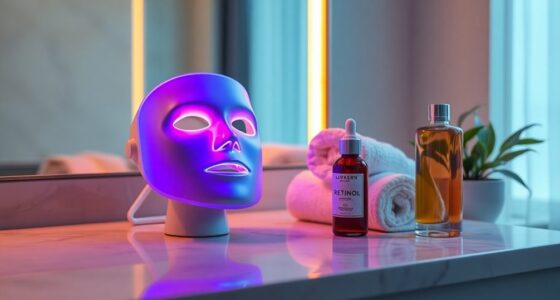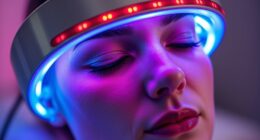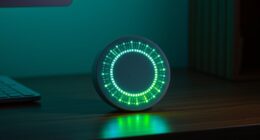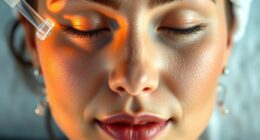To prevent breakouts along your hairline during LED treatments, make sure your device is clean and sanitized before each use. Avoid applying heavy or greasy products near your hairline and opt for lightweight, non-comedogenic formulas. Keep your scalp and hair thoroughly clean, and secure your hair away from your face. Also, use gentle products and monitor your skin’s response to adjust routines as needed. Staying mindful of these steps helps protect your skin; discover more tips inside.
Key Takeaways
- Keep your device and hair products clean to prevent bacteria buildup near the hairline.
- Use gentle, non-comedogenic products around the hairline before and after LED treatments.
- Protect sensitive areas with barriers like moisturizer if device instructions don’t specify safe zones.
- Wash hair thoroughly before treatments and avoid heavy styling products near the hairline.
- Monitor skin’s reaction, and reduce intensity or frequency if irritation or breakouts occur.
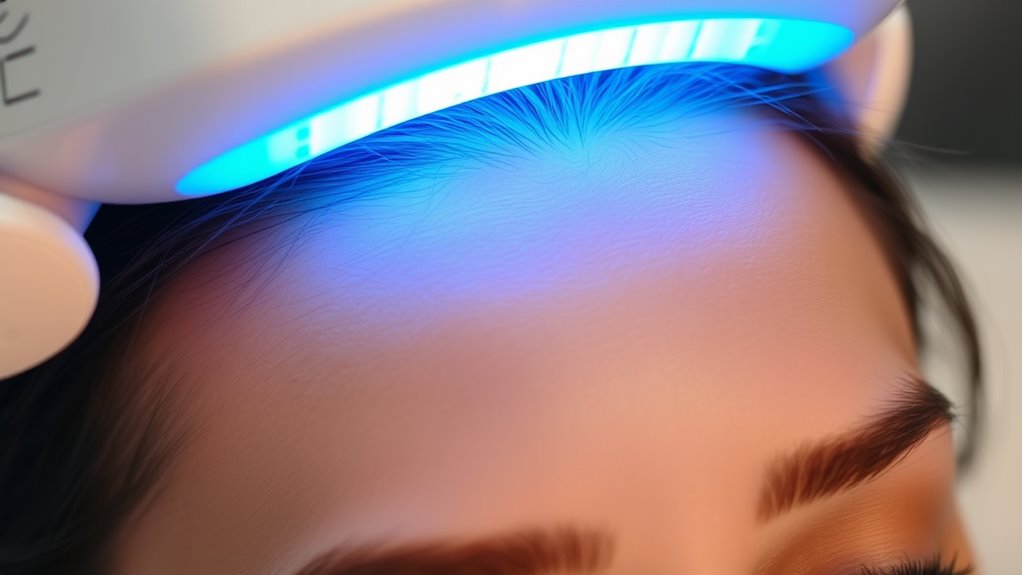
If you’re using LED treatments near your hairline, you might notice breakouts or irritation developing in that area. This is a common reaction and can be frustrating, especially since LED therapy is meant to improve your skin. The good news is, you can take steps to minimize these issues and continue benefiting from your treatments. First, it’s essential to understand that your skin might be sensitive or reacting to the LED device itself, the gel or serum you’re using, or even the way you’re applying the treatment. Identifying the cause helps you adjust your routine accordingly.
Start by examining the LED device you’re using. Confirm that it’s clean and sanitized before each session, as bacteria or dirt on the device can transfer to your skin and cause breakouts. Also, check if your device has specific instructions about where it’s safe to use around your hairline. Some devices may emit slightly different light intensities or wavelengths in certain areas, which can affect sensitive zones. If your device doesn’t specify, consider using a barrier, like a thin layer of moisturizer or a gentle serum, to protect your skin while still allowing the light to penetrate.
Next, look at the products you’re applying before and after your LED session. Many serums and gels contain ingredients that can clog pores or irritate sensitive skin, especially near the hairline where hair follicles are more concentrated. Avoid heavy, greasy, or comedogenic products in this area. Instead, opt for lightweight, non-comedogenic formulas that won’t clog pores or cause breakouts. If you notice irritation, try simplifying your routine by using only gentle hydrators or soothing products, and see if that helps reduce inflammation.
It’s also vital to pay attention to your hair and scalp. Sometimes, hair products like oils, pomades, or styling sprays can migrate onto your skin and clog pores, leading to breakouts. Before your LED treatment, wash your hair thoroughly and avoid applying heavy styling products near your hairline. Keeping this area clean reduces the risk of pore blockage and irritation. If you’re prone to breakouts, consider tying your hair back or using a soft headband to keep hair away from your face during treatments.
Finally, listen to your skin. If you notice persistent irritation or breakouts despite these precautions, it might be best to pause your LED treatments temporarily. When you resume, do so gradually, starting with shorter sessions or less intense settings. Regularly monitor your skin’s response and adjust your routine as needed. Incorporating consistent skin care and mindful product selection can help prevent future issues. Remember, preventing breakouts isn’t just about avoiding immediate irritation; it’s about creating a routine that respects your skin’s sensitivity and promotes overall health.
Frequently Asked Questions
Can LED Treatments Worsen Existing Skin Conditions Near the Hairline?
Yes, LED treatments can worsen existing skin conditions near your hairline if you have sensitivities or active inflammation. The light therapy may irritate or inflame compromised skin, leading to breakouts or discomfort. To avoid this, you should consult with a skincare professional beforehand, especially if you have conditions like eczema or dermatitis. Proper treatment customization and skin assessment help guarantee LED therapy benefits rather than harms your skin near the hairline.
How Long Should I Wait After LED Therapy Before Styling My Hair?
You should wait at least 24 to 48 hours after LED therapy before styling your hair. This allows your skin to recover and reduces the risk of irritation or breakouts caused by styling products or heat. During this time, avoid using heavy or oily products near your hairline. If your skin feels sensitive, consider waiting a bit longer before applying any styling products or heat tools.
Are There Specific Hair Products That Increase Breakout Risk Post-Led?
Yes, certain hair products can increase breakout risk after LED therapy. Avoid products with heavy oils, silicones, or fragrances, as they can clog pores and irritate your skin. Opt for lightweight, non-comedogenic formulas. Stick to gentle, dermatologist-recommended cleansers and avoid applying styling products directly on your face or hairline immediately after treatment. This helps minimize the risk of breakouts and keeps your skin clear and healthy.
Is There an Ideal Skin Type for Safe LED and Hairline Treatments?
Think of your skin as a delicate garden; some plants thrive more easily than others. For LED and hairline treatments, those with oily or acne-prone skin often face more challenges, like weeds overtaking flowers. If you have sensitive or dry skin, you’re more likely to enjoy a smooth, safe experience. Knowing your skin type helps you nurture your skin’s health and make sure treatments bloom beautifully without unwanted breakouts.
Can LED Devices Cause Sensitivity or Reactions on the Scalp?
Yes, LED devices can cause sensitivity or reactions on your scalp, especially if you have sensitive skin or allergies. You might notice redness, itching, or discomfort after treatment. To minimize these effects, follow the manufacturer’s instructions carefully, avoid overuse, and do a patch test first. If you experience persistent irritation, stop using the device and consult a dermatologist to ensure safe and effective treatment.
Conclusion
To keep your skin clear, remember that using LED therapy properly can markedly reduce breakouts—studies show up to 80% of users see improvements. Pay attention to your hairline, as buildup can cause irritation and pimples. By following these tips, you’ll minimize breakouts and enjoy healthier skin. Just stay consistent, and don’t forget to clean your devices regularly. With a little care, you’ll be on your way to a clearer, more confident you!

